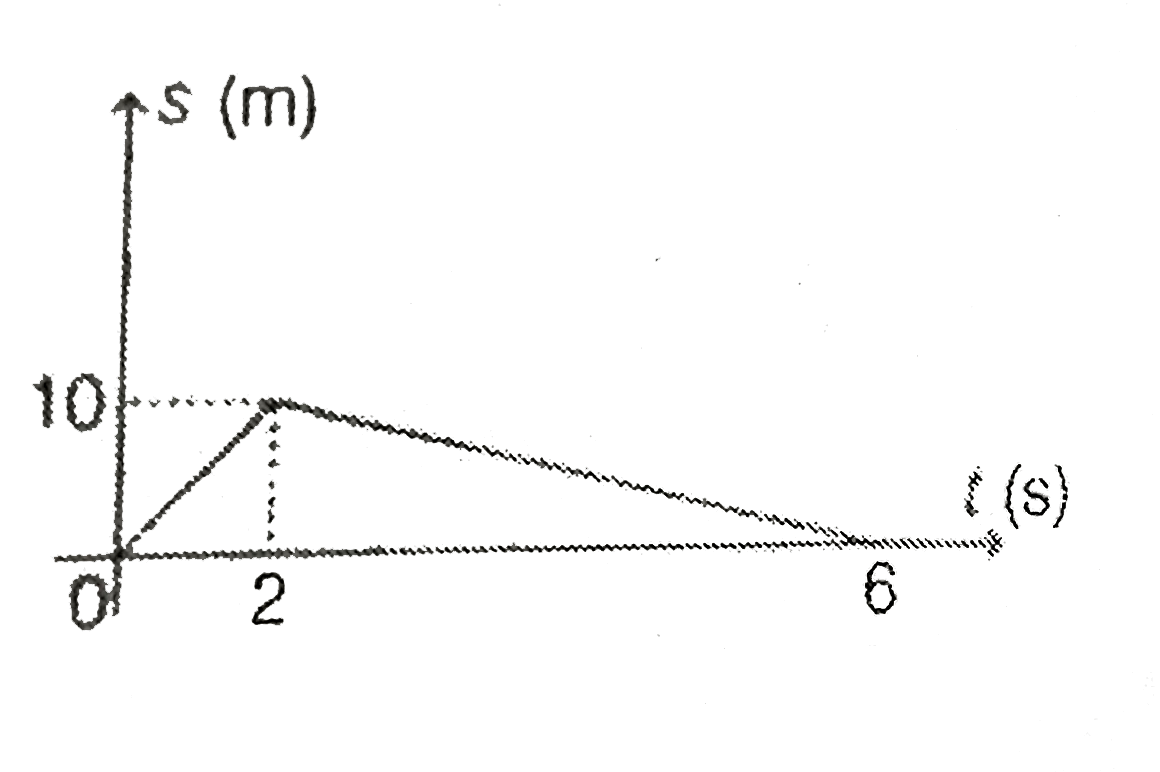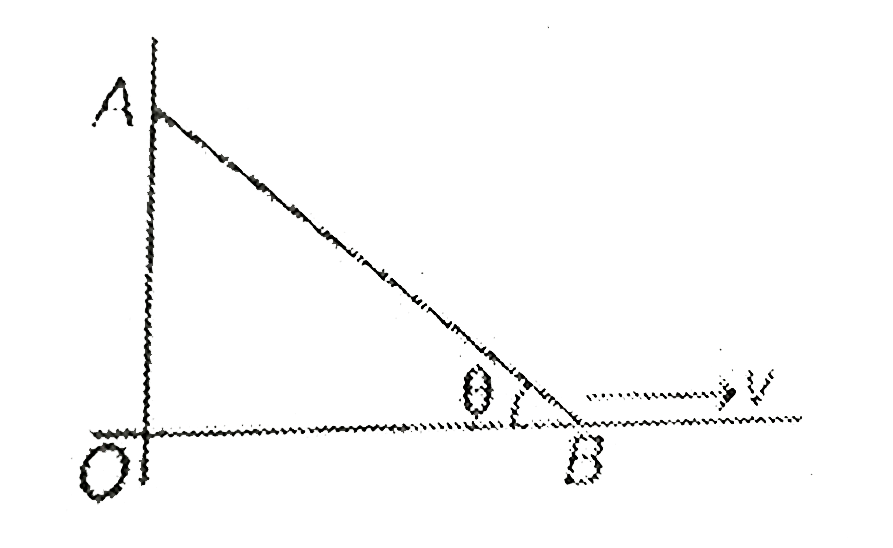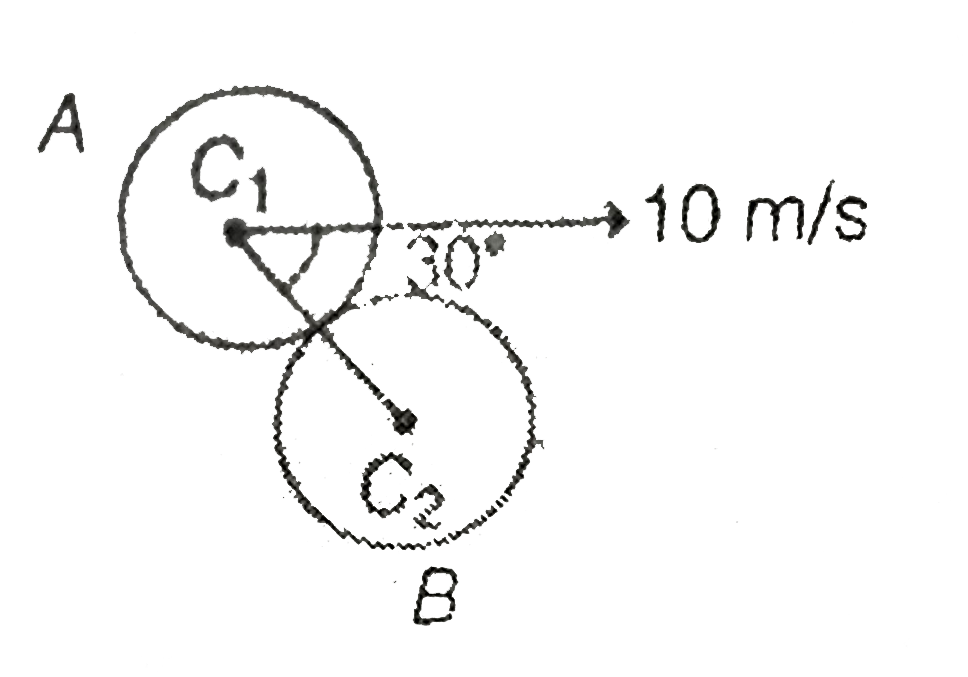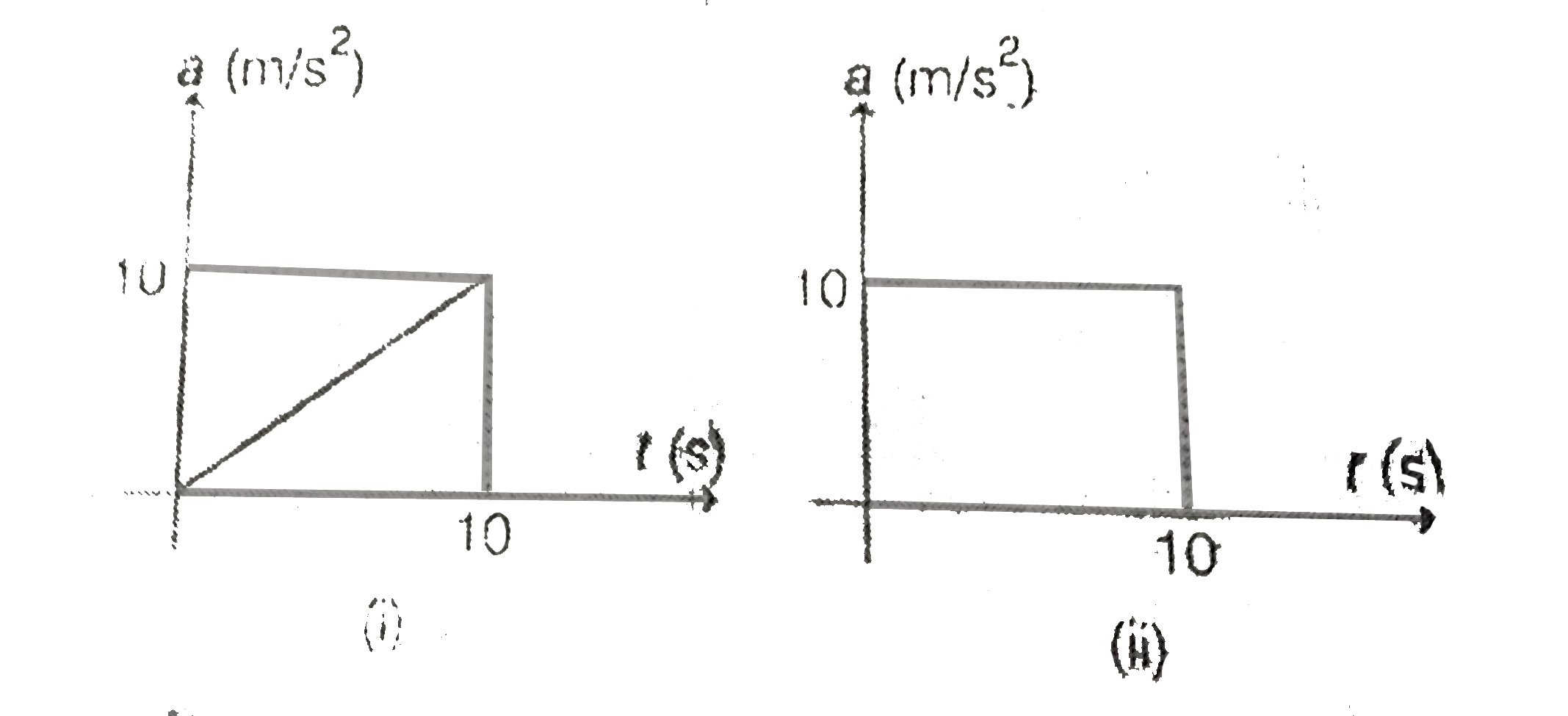Only one option is correct for JEE Advanced from DC PANDEY ENGLISH CENTRE OF MASS, IMPULSE AND MOMENTUM for Class 11
| Class 11 | PHYSICS |
| Chapter | CENTRE OF MASS, IMPULSE AND MOMENTUM |
| DC PANDEY ENGLISH | Only one option is correct for JEE Advanced |
| Medium | English |
| Academic Year | 2023-2024 |
Question 17
Two blocks of masses 3kg and 6kg respectivley are placed on a smooth horizontal surface. They are connected by a light spring of force constant k=200N/m. Initially the spring is unstretched. The indicated velocities are imparted to the blocks. Find the maximum extension of the spring.
 View Solution
View SolutionQuestion 25
A projectile of mass 3m explodes at highest point of its path. It breaks into three equalparts. One part retraces its path, the second one comes to rest. The range of the projectile was 100 m if no explosion would have taken place. The distance of the third part from the point of projection when it finally lands on the ground is -View SolutionQuestion 29
A man of mass 80 kg is riding on a small cart of mass 40 kg which is rolling along a level floor at a speed 2 m/s . He is running on the cart , so that his velocity relative to the cart is 3 m/s in the direction opposite to the motion of cart . What is the speed of the centre of the mass of the system ? View SolutionQuestion 35
A bead can slide on a smooth straight wire and a particle of mass m attached to the bead by a light string of length L. The particle is held in contact with the wire and with the string taut and is then let fall. If the bead has mass 2m then when the string makes an angle θ with the wire, the bead will have slipped a distance.
 View Solution
View SolutionQuestion 39
A boy of mass 60kg is standing over a platform of mass 40kg placed over a smooth horizontal surface. He throws a stone of mass 1kg with velocity v=10m/s at an angle of 45∘ with respect to the ground. Find the displacement of the platform (with boy) on the horizontal surface when the stone lands on the ground. Take g=10m/s2.View SolutionQuestion 42
A sphere is moving with velocity vector 2ˆi+2ˆj immediately before it hits a vertical wall. The wall is parallel to ˆj and the coefficient of restitution of the sphere and the wall is e=12. Find the velocity of the sphere after it hits the wall?
A.ˆi−ˆj B.−ˆi+2ˆj C.−ˆi−ˆj D.2ˆi−ˆjView SolutionQuestion 44
Infinite number of bricks are placed one over the other as shown in the figure. Each succeeding brick having half the length and breadth of its preceding brick and the mass of each succeeding bricks being (1/4)th of the preceding one. Taking 'O' as the origin, the x coordinate of centre of mass of the system of bricks is at
 View Solution
View SolutionQuestion 47
Choose the correct option:
Three blocks of identical masses are placed on a frictionless table as shown . The centre block is at rest , whereas the other two blocks are moving directly towards the stationary block with identical speed v . The centre block is initially closer to the left block than the right one . All collisions are elastic . After long time , which of the following is true .
 View Solution
View SolutionQuestion 48
A stream of water droplets, each of mass m = 0.001kg are fired horizontally at a velocity of 10m/s towards a vertical steel plate where they collide. The droplets one spaced equidistant with a spacing of 1cm.What is approximate average force exerted on the plate by the water droplets. (Assuming that they do not rebound after collision.) View SolutionQuestion 51
A hemisphere of radius R and mass 4 m is free to slide with its base on a smooth horizontal table . A particle of mass m is placed on the top of the hemisphere . The angular velocity of the particle relative to centre of hemisphere at an angular displacement θ when velocity of hemisphere has become v is View SolutionQuestion 52
Two blocks A and B of mass m and 2m respectively are connected by a light spring of force constant k. They are placed on a smooth horizontal surface. Spring is stretched by a length x and then released. Find the relative velocity of the blocks when the spring comes to its natural length
 View Solution
View SolutionQuestion 53
A ball of mass m approaches a heavy wall of mass M with speed 4 m/s along the normal to the wall. The speed of wall before collision is 1m/s towards the ball. The ball collides elastically with the wall. What can you say about the speed of the ball after collision? Will it be slightly less than or slightly higher than 6 m/s ? View SolutionQuestion 60
A block A slides over an another block B which is placed over a smooth inclined plane as shown in figure . The coefficient of friction between the two blocks A and B is μ . Mass of block B is two times the mass of block A . The acceleration of the centre of mass of two blocks is
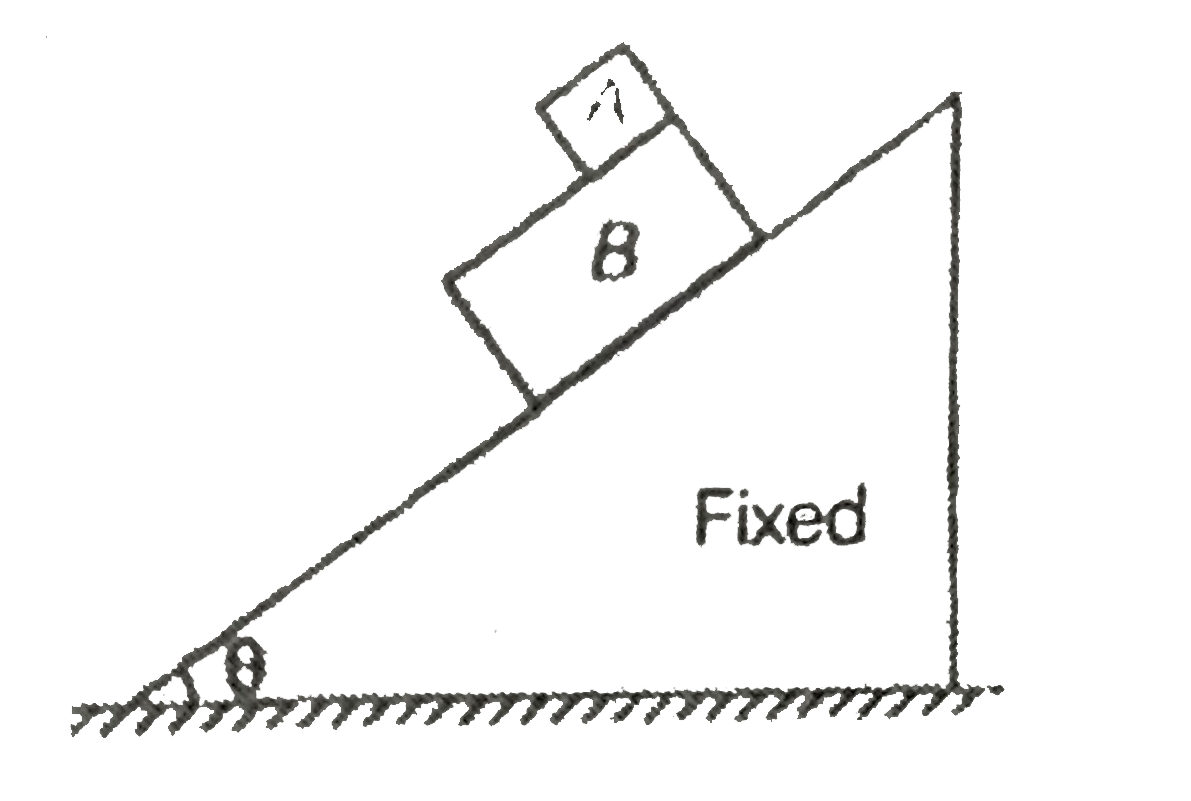 View Solution
View SolutionQuestion 64
A rope thrown over a pulley has a ladder with a man of mass m on one of its ends and a counter balancing mass M on its other end. The man climbs with a velocity vr relative to ladder. Ignoring the masses of the pulley and the rope as well as the friction on the pulley axis, the velocity of the centre of mass of this system is:View SolutionQuestion 66
A particle of mass 2m is projected at an angle of 45∘ with horizontal with a velocity of 20√2m/s. After 1s explosion takes place and the particle is broken into two equal pieces. As a result of explosion one part comes to rest. Find the maximum height attained by the other part. Take g=10m/s2.View SolutionQuestion 67
Choose the correct option:
A system of two blocks A and B and a wedge C are released from rest as shown in figure . Masses of the blocks and the wedge are m , 2m and 2m respectively . The displacement of wedge C when block B slides down the plane a distance 10 cm is ( neglect friction )
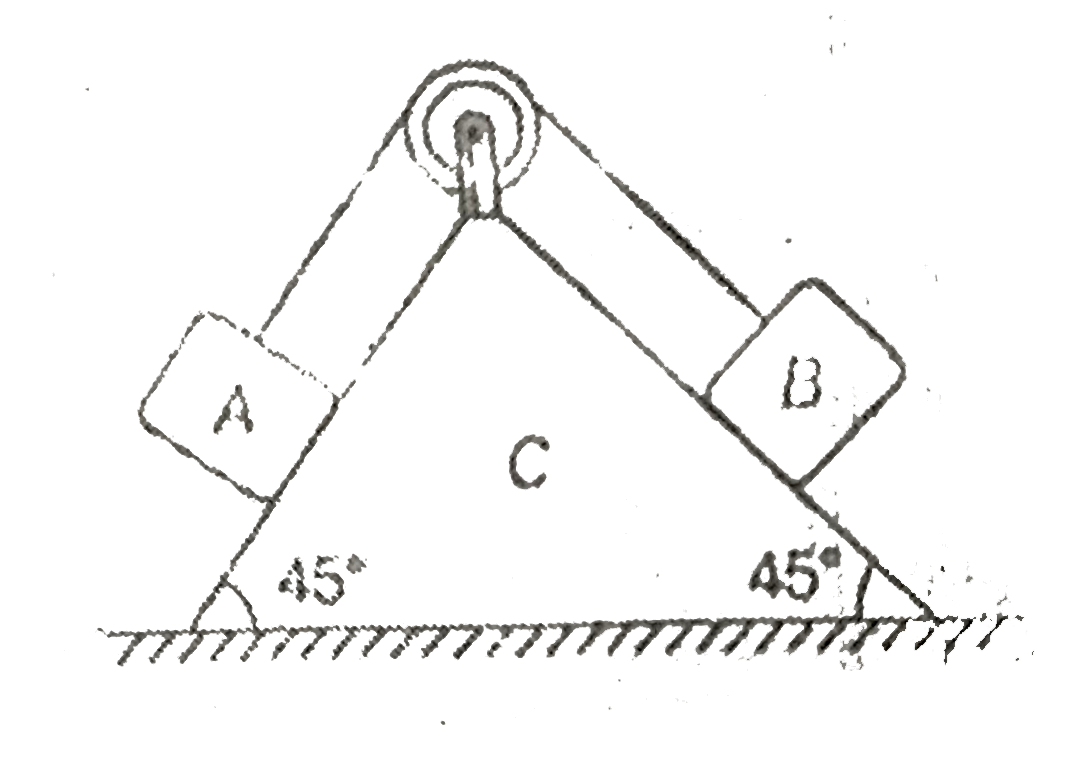 View Solution
View SolutionQuestion 68
A small sphere of radius R is held against the inner surface of larger sphere of radius 6R (as shown in figure). The masses of large and small spheres are 4M and M respectivley. This arrangement is placed on a horizontal table. There is no friction between any surfaces of contact. The small sphere is now released. Find the coordinates of the centre of the large spheres, when the smaller sphere reaches the other extreme position.
 View Solution
View SolutionQuestion 70
Two particles A and B of equal mass m are attached by a string of length 2l and initially placed over a smooth horizontal table in the positoin shown in fig. particle B is projected across the table with speed u perpendicular to AB as shown in the figure. find the velocities of each particle after the string becomes taut and the magnitude of the impulse tension. View Solution
View SolutionQuestion 71
A mass m rests on a horizontal table. It is attached to a light inextensible string which passes over a smooth pulley and carries a mass m at the other end. If the mass m is raised vertically through a distance h and is then dropped, what is the speed with which the mass 2m begins to rise? View Solution
View SolutionQuestion 73
A small block of mass M moves with velocity 5 m/s towards an another block of same mass M placed at a distance of 2 m on a rough horizontal surface . Coefficient of friction between the blocks and ground is 0.25 . Collision between the two blocks is elastic , the separation between the blocks , when both of them come to rest , is ( g = 10m/s2)View SolutionQuestion 76
A body of mass m0 is placed on a smooth horizontal surface . The mass of the body is decreasing exponentially with disintegration constant , λ . Assuming that the mass is ejected backwards with a relative velocity u . If initially the body was at rest , the speed of body at time t is View SolutionQuestion 79
Two particles one of mass m and the other of mass 2 m are projected horizontally towards each other from the same level above the ground with velocities 10 m/s and 5 m/s respectively . They collide in air and stick to each other . The distance from A , where the combined mass finally land is
 View Solution
View SolutionQuestion 81
A ball is projected from the point O with velocity 20 m/s at an angle of 60∘ with horizontal as shown in figure. At highest point of its trajectory it strikes a smooth plane of inclination 30∘ at point A. The collision is perfectly inelastic. The maximum height from the ground attained by the ball is (g=10m/s2)
 View Solution
View SolutionQuestion 85
Two blocks of mass m and 2m are kept on a smooth horizontal surface. Theya are connected by an ideal spring of force constant k. Initially the spring is unstretched. A constant force is applied to the heavier block in the direction shown in figure. Suppose at time t displacement of smaller block is x1 then displacement of the heavier block at this moment would be
 View Solution
View SolutionQuestion 86
Blocks A and B shown in the figure are having equal masses m. The system is released from rest with the spring unstretched. The string between A and ground is cut, when there is maximum extension in the spring. The acceleration of centre of mass of the two blocks at this instant is
 View Solution
View SolutionQuestion 88
A particle of mass 3m is projected from the ground at some angle with horizontal. Its horizontal range is R. At the highest point of its path it breaks into two pieces of masses m and 2m respectively. The smallar mass comes to rest. The larger mass finally falls at a distance x from the point of projection where x is equal to
(A)43R (B)32R (C)54R (D)2.5RView SolutionQuestion 90
Choose the correct answer:
A ball collides at B with velocity 10m/s at 30∘ with vertical. There is a flag at A and a wall at C. Collision of ball with ground is perfectly inelastic (e=0) and that with wall is elastic (e=1). Given AB=BC=10m. Find the time after which ball will collide with the flag.
 View Solution
View SolutionQuestion 96
A block of mass M with a semicircualr of radius R, rests on a horizontal frictionless surface. A uniform cylinder of radius r and mass m is released from rest the top point A The cylinder slips on the semicircular frictionless track. How far has the block moved when the cylinder reaches the bottom (point B) of the track ? How fast is the block moving when the cylinder reaches the bottom of the track?
 View Solution
View SolutionQuestion 97
A block of mass M with a semicircualr of radius R, rests on a horizontal frictionless surface. A uniform cylinder of radius r and mass m is released from rest the top point A The cylinder slips on the semicircular frictionless track. How far has the block moved when the cylinder reaches the bottom (point B) of the track ? How fast is the block moving when the cylinder reaches the bottom of the track?
 View Solution
View SolutionQuestion 99
A small ball on a frictionless horizontal surface moves towards right with velocity v. It collides with the wall and returns back and continues to and fro motion. If the average speed for first to and fro motion of the ball is (23)v, then the coefficient of restitution of impact is
 View Solution
View SolutionQuestion 100
A body of mass m is dropped from a height of h. Simultaneously another body of mass 2m is thrown up vertically with such a velocity v that they collide at height h2. If the collision is perfectly inelastic, the velocity of combined mass at the time of collision with the ground will be View SolutionQuestion 101
Choose the correct option:
Two bars of masses m1 and m2 connected by a weightless spring of stiffness k, rest on a smooth horizontal plane. Bar 2 is shifted by a small distance x0 to the left and released. The velocity of the centre of mass of the system when bar 1 breaks off the wall is
 View Solution
View SolutionQuestion 102
A rocket is projected vertically upwords. It explodes at the/ topmost point of its trajectory into three identical fragments . One of the fragments comes straight down in time t 1 while the1 other two land at a time t2 after explosion. Find the height at which the explosion ocurred in terms of t1andt2 ?
 View Solution
View SolutionQuestion 104
Choose the correct option:
A small block of mass 'm' is placed on bigger block of mass M1 which is placed on a frictionless horizontal surface. The two blocks are given equal speed u1 but opposite directions, as shown in the figure. After sometime, it is observed that both blocks are moving in the direction of motion of the lower block, with a speed greater than u2. It can be concluded that -
 View Solution
View SolutionQuestion 105
Choose the correct option:
A trolley is moving horizontally with a constant velocity of vm/s w.r.t. earth. A man starts running from one end of the trolley with velocity 1.5vm/s w.r.t. to trolley. After reaching the opposite end, the man return back and continues running with a velocity of 1.5vm/s w.r.t. the trolley in the backward direction. If the length of the trolley is L then the displacement of the man with respect to earth during the process will be :-
 View Solution
View SolutionQuestion 108
Three masses A, B and C are kept on a smooth horizontal surface as shown in the fiugre. A sharp impulse is given to the mass A, so that it starts moving towards B with speed v0. What is the minimum value of m so that there is only one collision between masses A and B (all collisions are elastic)
 View Solution
View SolutionQuestion 109
A block of mass m is attached with a spring of force constant k. The block is kept on a frictionless plank. Mass of the plank is M and it is also kept on a horozontal frictionless surface. Initially the sysetm is stationaryl. An impulse p is applied on the block as shown. The maximum copression in the spring will be View Solution
View SolutionQuestion 118
A projectile is fixed on a horizontal ground. Coefficient of restitution between the projectile and the ground is 'e'. If a,b and c be the ration of time of flight [T1T2], maximum height [H1H2] and horizontal range [R1R2] in first two collisions with the ground, then a, b and c in terms of 'e' will be View SolutionQuestion 122
A ball B of mass m is lying at rest on the top surface of a smooth horizontal table 5 m high. Another moovin ball A of same mass make an elastic colision with B slides off the table and strikes the floor at a horizonatal distance of 10 m from the table. Then select the correct alternatives (s). [g=10m/s2]View SolutionQuestion 130
Blocks of masses 0.5 kg each, resting on a horizontal frictionless tabletop, are connected with an unstrethched speing of length L = 20 cm, and of spring constant 16 N/m. The mass of the spring is negligible art a certain moment the blocks are given an initial speed of v0=0.36m/s towards the wall. The block at the right collides with the wall elastically :
 View Solution
View SolutionQuestion 131
Two identical particles A and B of mass m each are connected together by a light and inextensible string of length l. The particle are held at rest in air in same horizontal level at a separation I. Both particles are released simultaneously and one of them (say A) is given speed V0 vertically upward. Choose the correct options (s). Ignore air resistance.View SolutionQuestion 133
In the figure shiown a stationary boy (at a poing A ) throws a ball towards a fixed wall which is 20 m away from him. The ball hits the wall elastically and hits the ground at the point B, 20 m behind the boy. The total tiem elapsed id T1 The boy again throws the ball with same speed but at different angle from same point A towards the wall and after collision with the wall ball lands at same point B. But this time elapsed is T2.If (T2−T1) = 1s, choose the correct potions.
 View Solution
View SolutionQuestion 134
Comprehension # 1
If net force on a system in a particular direction is zero (say in horizontal direction), we can apply: ΣmRxR=ΣmLxL,ΣmRvR=ΣmLvL and ΣmRaR=ΣmLaL
Here R stands for the masses which are moving towards right and L for the masses towards left, x is displacement, v is velocity and a the acceleration (all with respect to ground).
A small block of mass m=1kg is placed over a wedge of mass M=4kg as shown in figure. Mass m is released from rest. All surface are smooth. Origin O is as shown.

Final velocity of the wedge is ..........m/s :-View SolutionQuestion 135
Comprehension # 1
If net force on a system in a particular direction is zero (say in horizontal direction), we can apply: ΣmRxR=ΣmLxL,ΣmRvR=ΣmLvL and ΣmRaR=ΣmLaL
Here R stands for the masses which are moving towards right and L for the masses towards left, x is displacement, v is velocity and a the acceleration (all with respect to ground).
A small block of mass m=1kg is placed over a wedge of mass M=4kg as shown in figure. Mass m is released from rest. All surface are smooth. Origin O is as shown.

The block will strike the x-axis at x= ............ m :-View SolutionQuestion 136
Comprehension # 1
If net force on a system in a particular direction is zero (say in horizontal direction), we can apply: ΣmRxR=ΣmLxL,ΣmRvR=ΣmLvL and ΣmRaR=ΣmLaL
Here R stands for the masses which are moving towards right and L for the masses towards left, x is displacement, v is velocity and a the acceleration (all with respect to ground).
A small block of mass m=1kg is placed over a wedge of mass M=4kg as shown in figure. Mass m is released from rest. All surface are smooth. Origin O is as shown.

Normal reaction between the two blocks at an instant when absolute acceleration of m is 5√3m/s2 at 60∘ with horizontal is ......... N. Normal reaction at this instant is making 30∘ with horizontal.View SolutionQuestion 137
Comprehension # 1
If net force on a system in a particular direction is zero (say in horizontal direction) we can apply:
ΣmRxR=ΣmLxL,ΣmRvR=ΣmLvL and ΣmRaR=ΣmLaL
Here R stands for the masses which are moving towards right and L for the masses towards left, x is displacement, v is velocity and a the acceleration (all with respect to ground). A small block of mass m=1kg is placed over a wedge of mass M=4kg as shown in figure. Mass m is released from rest. All surface are smooth. Origin O is as shown.

At the same instant reaction on the wedge from the ground is ........N.View SolutionQuestion 138
Comprehension # 2
When two bodies collide normally they exert equal and opposite impulses on each other. Impulse = change in linear momentum. Coefficient of restitution between two bodies is given by :- e=|Relative velocity of separation||Relative velocity of approach|=1, for elastic collision.

Two bodies collide as shown in figure. During collision they exert impulse of magnitude J on each other.
If the collision is elastic, the value of J is ............. Ns.View SolutionQuestion 139
Comprehension # 2
When two bodies collide normally they exert equal and opposite impulses on each other. Impulse = change in linear momentum. Coefficient of restitution between two bodies is given by :-
e=|Relative velocity of separation||Relative velocity of approach|=1, for elastic collision

Two bodies collide as shown in figure. During collision they exert impulse of magnitude J on each other.
For what value of J (in Ns ) the 2kg block will change its direction of velocity?View SolutionQuestion 140
Two identiacal masses are as shown in figure. One is thrown upwards with velocity 20 m/s and another is just dropped simultaneously.
The masses collide I air and stick together. After how much time the combined mass will fall to the gorund (calculate the time from the starting when the motion was started )
 View Solution
View SolutionQuestion 143
Comprehension # 4
When the mass of a system is variable, a thrust force has to be applied on it in addition to all other forces acting on it. This thrust force is given by : →F=→vr(±dmdt). Here →vr is the relative velocity with which the mass dm either enters or leaves the system.

A car has total mass 50kg. Gases are ejected from its backwards with relative velocity 20m/s. The rate of ejection of gas is 2kg/s. Total mass of gas is 20kg. Coefficient of friction between the car and road is μ=0.1.
Car will start moving after time t=.........s.View SolutionQuestion 144
Comprehension # 4
When the mass of a system is variable, a thrust force has to be applied on it in addition to all other forces acting on it. This thrust force is given by : →F=→vr(±dmdt). Here →vr is the relative velocity with which the mass dm either enters or leaves the system.

A car has total mass 50kg. Gases are ejected from its backwards with relative velocity 20m/s. The rate of ejection of gas is 2kg/s. Total mass of gas is 20kg. Coefficient of friction between the car and road is μ=0.1.
Maximum speed of car will be v=.......m/s :- (Take ln(43)=0.28 )View SolutionQuestion 145
A car has total mass 50 kg. Gases are ejected from this car backwards with relative velocity 20 m/s. The rate of ejection of gases is 2 kg/s. Total mass of gas is 20 kg. Coefficient of friction between the car and road is μ=0.1

Car will start moving after time t=.......... second. View SolutionQuestion 148
Comprehension # 5
One particle of mass 1kg is moving along positive x-axis with velocity 3m/s. Another particle of mass 2kg is moving along y-axis with 6m/s. At time t=0,1kg mass is at (3m,0) and 2kg at (0,9m),x−y plane is the horizontal plane. (Surface is smooth for question 1 and rough for question 2 and 3)
The centre of mass of the two particles is moving in a straight line for which equation is :View SolutionQuestion 149
Comprehension # 5
One particle of mass 1kg is moving along positive x-axis with velocity 3m/s. Another particle of mass 2kg is moving along y-axis with 6m/s. At time t=0,1kg mass is at (3m,0) and 2kg at (0,9m),x−y plane is the horizontal plane. (Surface is smooth for question 1 and rough for question 2 and 3)
If both the particles have the same value of coefficient of friction μ=0.2. The centre of mass will stop at time t= ..........s :-View SolutionQuestion 150
Comprehension # 5
One particle of mass 1kg is moving along positive x-axis with velocity 3m/s. Another particle of mass 2kg is moving along y-axis with 6m/s. At time t=0,1kg mass is at (3m,0) and 2kg at (0,9m),x−y plane is the horizontal plane. (Surface is rough for question, if cofficient of friction is 0.2 in both axis)
Co-ordinates of center of mass where it will stop finally are :-View SolutionQuestion 153
A block of mass 1 kg is moving towards a movable wedge of mass 2 kg as shown in figure. All surfaces are smooth. When the block leaves the wedge from top, its velocity is making an angle θ=30∘ with horizontal.

In the whole process let J be the magnitude of net impulse given to the block by the wedge, JH its horizontal component and JV its vertical component. Then View SolutionQuestion 157
Comprehension # 6
A 1kg block is given a velocity of 15m/s towards right over a very long rough plank of mass 2kg as shown in figure.

If coefficient of friction between the two blocks is equal to 0.4, then magnitude of initial slope of p1 versus t and p2 versus t (in SI unit) will be :-View SolutionQuestion 159
A ball of mass 3 kg is thrown upwards with velocity 20 m/s. After 1 s it explodes in 2 pieces one of mass 1 kg and other or 2 kg. After explosion both the pices maintain their vertical velocities but on ground they fall 90 m aport.
Speed of both the pieces just after explosion are (both in m/s)View SolutionQuestion 160
A ball of mass 3 kg is thrown upwards with velocity 20 m/s. After 1 s it explodes in 2 pieces one of mass 1 kg and other or 2 kg. After explosion both the pices maintain their vertical velocities but on ground they fall 90 m aport
Energy produced (in joule) during explosion is View SolutionQuestion 161
Two blocks of equal mass m are connected by an unstretched spring and the system is kept at rest on a frictionless horizontal surface. A constant force F is applied on the first block pulling away from the other as shown in Fig.

Then the displacement of the centre of mass in at time t isView SolutionQuestion 162
Two blocks of equal mass m are connected by an unstretched spring and the system is kept at rest on a frictionless horizontal surface. A constant force F is applied on the first block pulling away from the other as shown in Fig.
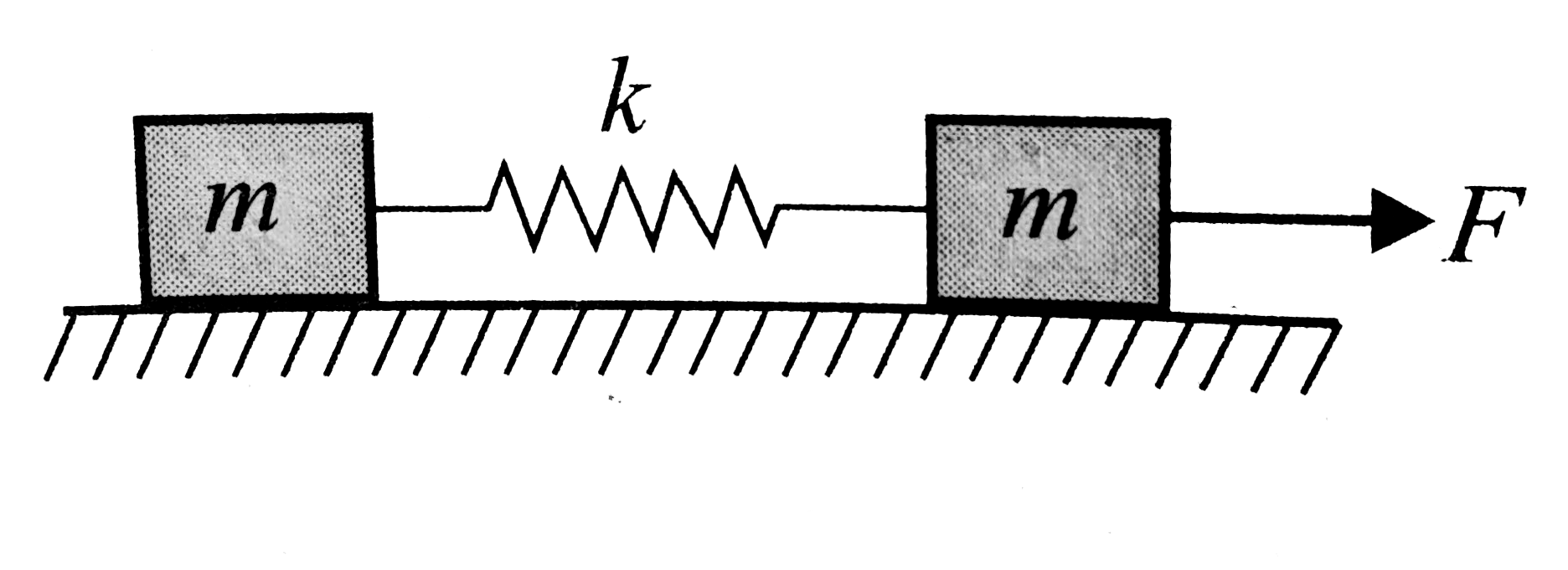
If the extension of the spring is x0 at time t, then the displacement of the first block at this instant is View SolutionQuestion 163
Two blocks of equal mass m are connected by an unstretched spring and the system is kept at rest on a frictionless horizontal surface. A constant force F is applied on the first block pulling away from the other as shown in Fig.

If the extension of the spring is x0 at time t, then the displacement of the first block at this instant is View SolutionQuestion 164
Two balls marked 1 and 2 of the same mass m and a third ball marked 3 of mass M are arranged over a smooth horizontal surface as shown in the figure. Ball 1 moves with a velocity v1 towards ball 2. All collisions are assumed to be elastic. If M<m, the number of collisions between the balls will be.
 View Solution
View SolutionQuestion 165
Two balls marked 1 and 2 of the same mass m and a third ball marked 3 of mass M are arranged over a smooth horizontal surface as shown in the figure. Ball 1 moves with a velocity v1 towards ball 2. All collisions are assumed to be elastic. If M<m, the number of collisions between the balls will be.
 View Solution
View SolutionQuestion 166
A system consists of block A and B each of mass m connected by a light spring as shown in the figure with block B in contact with a wall. The block A compresses the spring by 3mg/k from natural length of spring and then released from rest. Neglect friction anywhere

Acceleration of centre of mass of system comprising A and B just after A is released is View SolutionQuestion 167
A system consists of block A and B each of mass m connected by a light spring as shown in the figure with block B in contact with a wall. The block A compresses the spring by 3mg/k from natural length of spring and then released from rest. Neglect friction anywhere.
Velocity of centre of mass of system comprising A and B when block B just loses contact with the wall View SolutionQuestion 170
A particle of mass m, kinetic energy K and momentum p collides head on elastically with another of mass 2 m at rest. Match the following columns after collision.)
column1column2A momentum of first particleP 3/4 pB Momentum of second particleQ -K/9C Kinetic energy of first particleR -p/3D Kinetic energy of second particleS 8K/9View SolutionQuestion 174
Two balls of mass m and 2m each have momentum 2p and p in the direction shown in figure. During collision they exert an impulse of magnitude p on each other.

Column IColumn II(A)After collision momentum of m(p)2p(B)After collision momentum of 2m(q)p(C)Coefficient of restitution between them(r)1(s)NoneView Solution












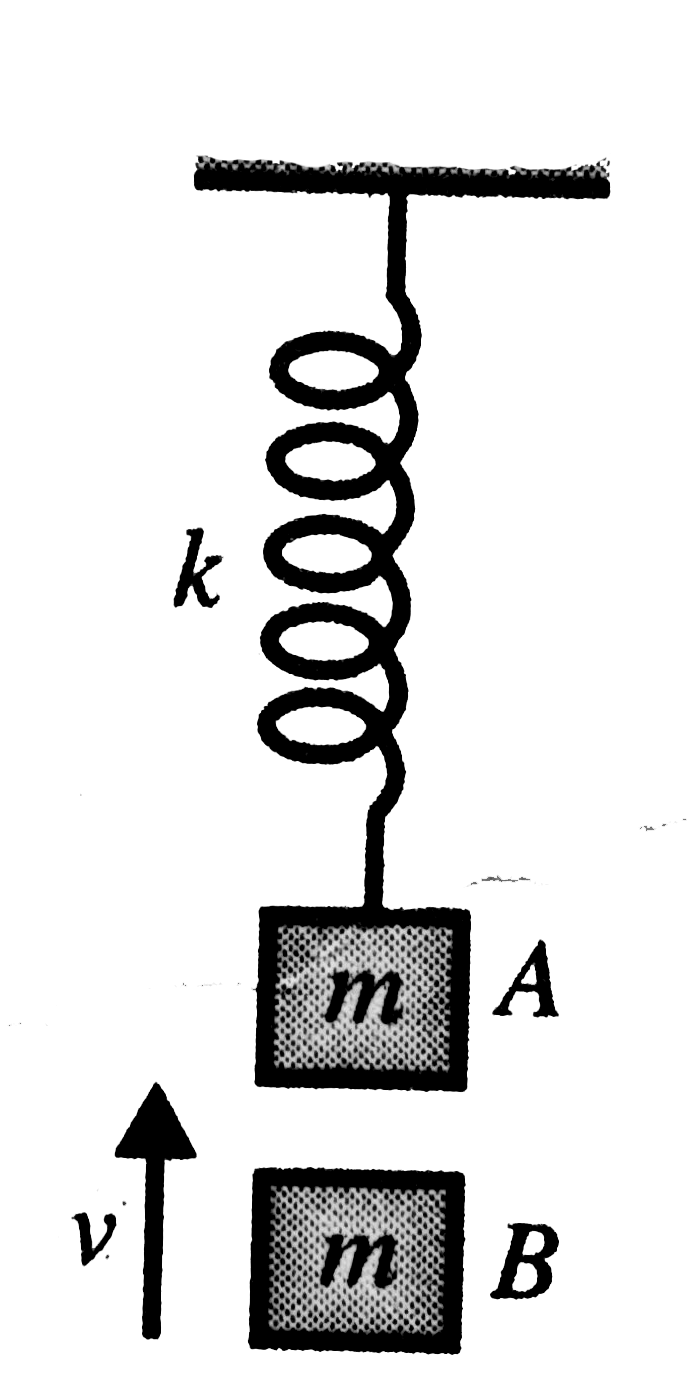


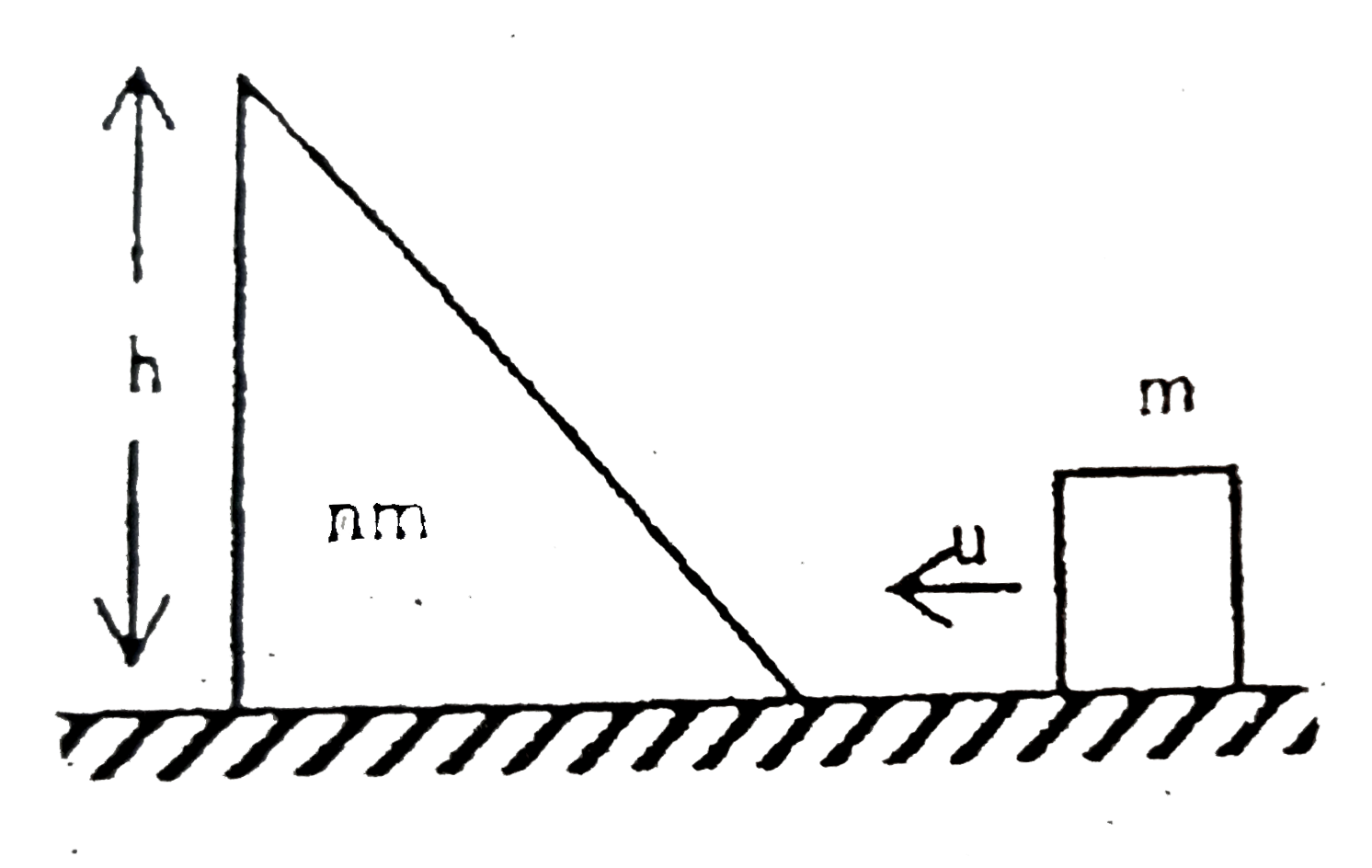




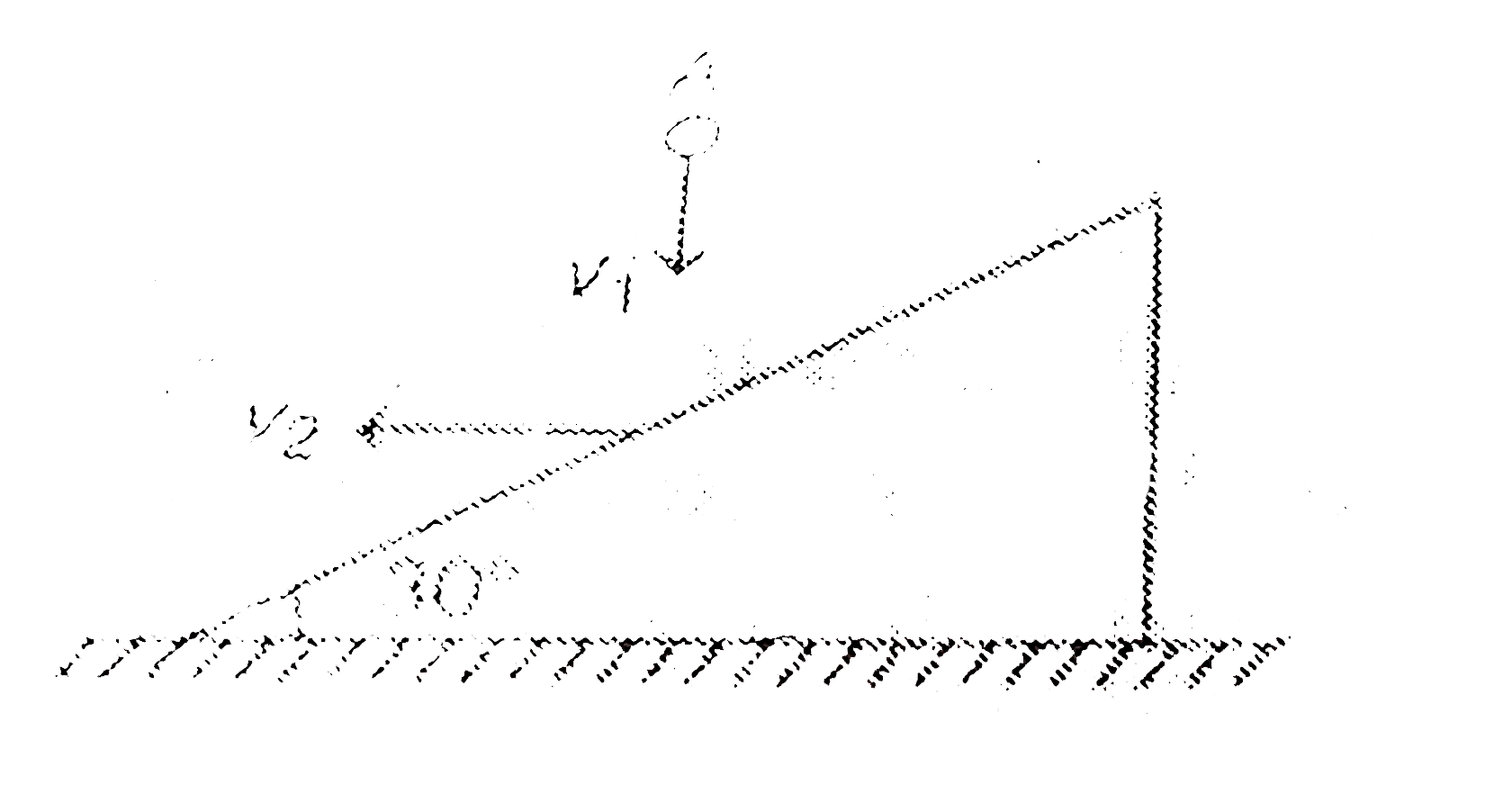
 .
. .
.

